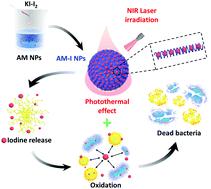当前位置:
X-MOL 学术
›
J. Mater. Chem. B
›
论文详情
Our official English website, www.x-mol.net, welcomes your
feedback! (Note: you will need to create a separate account there.)
Facile synthesis of monodisperse chromogenic amylose–iodine nanoparticles as an efficient broad-spectrum antibacterial agent
Journal of Materials Chemistry B ( IF 6.1 ) Pub Date : 2020-02-27 , DOI: 10.1039/d0tb00161a Yanbin Sun 1, 2, 3, 4 , Xianwen Wang 1, 2, 3, 4 , Linxin Fan 1, 2, 3, 4 , Xianli Xie 2, 3, 4, 5 , Zhaohua Miao 1, 2, 3, 4 , Yan Ma 1, 2, 3, 4 , Tao He 2, 3, 4, 5 , Zhengbao Zha 1, 2, 3, 4
Journal of Materials Chemistry B ( IF 6.1 ) Pub Date : 2020-02-27 , DOI: 10.1039/d0tb00161a Yanbin Sun 1, 2, 3, 4 , Xianwen Wang 1, 2, 3, 4 , Linxin Fan 1, 2, 3, 4 , Xianli Xie 2, 3, 4, 5 , Zhaohua Miao 1, 2, 3, 4 , Yan Ma 1, 2, 3, 4 , Tao He 2, 3, 4, 5 , Zhengbao Zha 1, 2, 3, 4
Affiliation

|
The famous chromogenic reaction between starch and iodine has been widely used for chemical analysis since its first discovery in the year of 1814 while it is seldom utilized in biomedical applications. Inspired by their high iodine content and strong optical absorbance in the near infrared (NIR) region, monodisperse amylose–iodine nanoparticles (AM–I NPs), synthesized by simple mixing of amylose NPs and KI–I2 solutions, were explored as a new class of high-performance antibacterial agent. Benefiting from the broad-spectrum antibacterial property of iodine and photothermal effect of the amylose–iodine complex, the obtained AM–I NPs exhibited an excellent photothermal-enhanced sterilization effect for both Gram-negative Escherichia coli (E. coli) and Gram-positive methicillin-resistant Staphylococcus aureus (MRSA). For instance, upon incubation with AM–I NP suspensions (30 μg mL−1) plus NIR laser irradiation (808 nm, 1.33 W cm−2, 5 min), the relative survival rates of E. coli and MRSA were only 1.2% and 1.7%, respectively. In addition, the AM–I NPs depicted better biocompatibility in vitro than that of KI–I2 solution, indicating their safety for potential biomedical applications in vivo. This proof-of-concept study revealed the antibacterial applications of a traditional starch-iodine complex and is expected to provide insights into the design and development of efficient broad-spectrum antibacterial agents.
中文翻译:

易于合成的单分散发色直链淀粉-碘纳米颗粒,作为一种有效的广谱抗菌剂
自1814年首次发现以来,淀粉和碘之间著名的显色反应已被广泛用于化学分析,但很少在生物医学应用中使用。受其高碘含量和在近红外(NIR)区域强吸光度的启发,探索了通过简单混合直链淀粉NP和KI–I 2溶液而合成的单分散直链淀粉-碘纳米颗粒(AM–I NP)。类高性能抗菌剂。从碘的广谱抗菌性和的直链淀粉-碘复合物,将得到的AM-I的NP显示出优异的光热增强杀菌革兰氏阴性效果光热效应受益大肠杆菌(大肠杆菌)和耐甲氧西林的金黄色葡萄球菌(MRSA)。例如,与AM-1 NP悬浮液(30μgmL -1)结合NIR激光照射(808 nm,1.33 W cm -2,5分钟)一起孵育时,大肠杆菌和MRSA的相对存活率仅为1.2%和1.7%。此外,AM–I NPs在体外的生物相容性比KI–I 2溶液更好,表明它们对体内潜在生物医学应用的安全性。这项概念验证研究揭示了传统淀粉-碘复合物的抗菌应用,有望为高效广谱抗菌剂的设计和开发提供见识。
更新日期:2020-02-27
中文翻译:

易于合成的单分散发色直链淀粉-碘纳米颗粒,作为一种有效的广谱抗菌剂
自1814年首次发现以来,淀粉和碘之间著名的显色反应已被广泛用于化学分析,但很少在生物医学应用中使用。受其高碘含量和在近红外(NIR)区域强吸光度的启发,探索了通过简单混合直链淀粉NP和KI–I 2溶液而合成的单分散直链淀粉-碘纳米颗粒(AM–I NP)。类高性能抗菌剂。从碘的广谱抗菌性和的直链淀粉-碘复合物,将得到的AM-I的NP显示出优异的光热增强杀菌革兰氏阴性效果光热效应受益大肠杆菌(大肠杆菌)和耐甲氧西林的金黄色葡萄球菌(MRSA)。例如,与AM-1 NP悬浮液(30μgmL -1)结合NIR激光照射(808 nm,1.33 W cm -2,5分钟)一起孵育时,大肠杆菌和MRSA的相对存活率仅为1.2%和1.7%。此外,AM–I NPs在体外的生物相容性比KI–I 2溶液更好,表明它们对体内潜在生物医学应用的安全性。这项概念验证研究揭示了传统淀粉-碘复合物的抗菌应用,有望为高效广谱抗菌剂的设计和开发提供见识。


















































 京公网安备 11010802027423号
京公网安备 11010802027423号